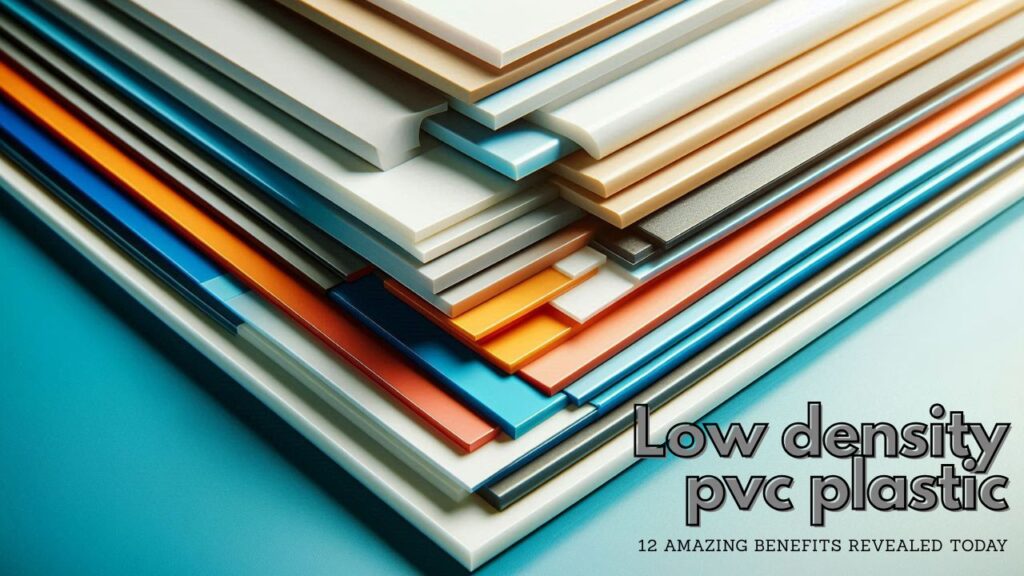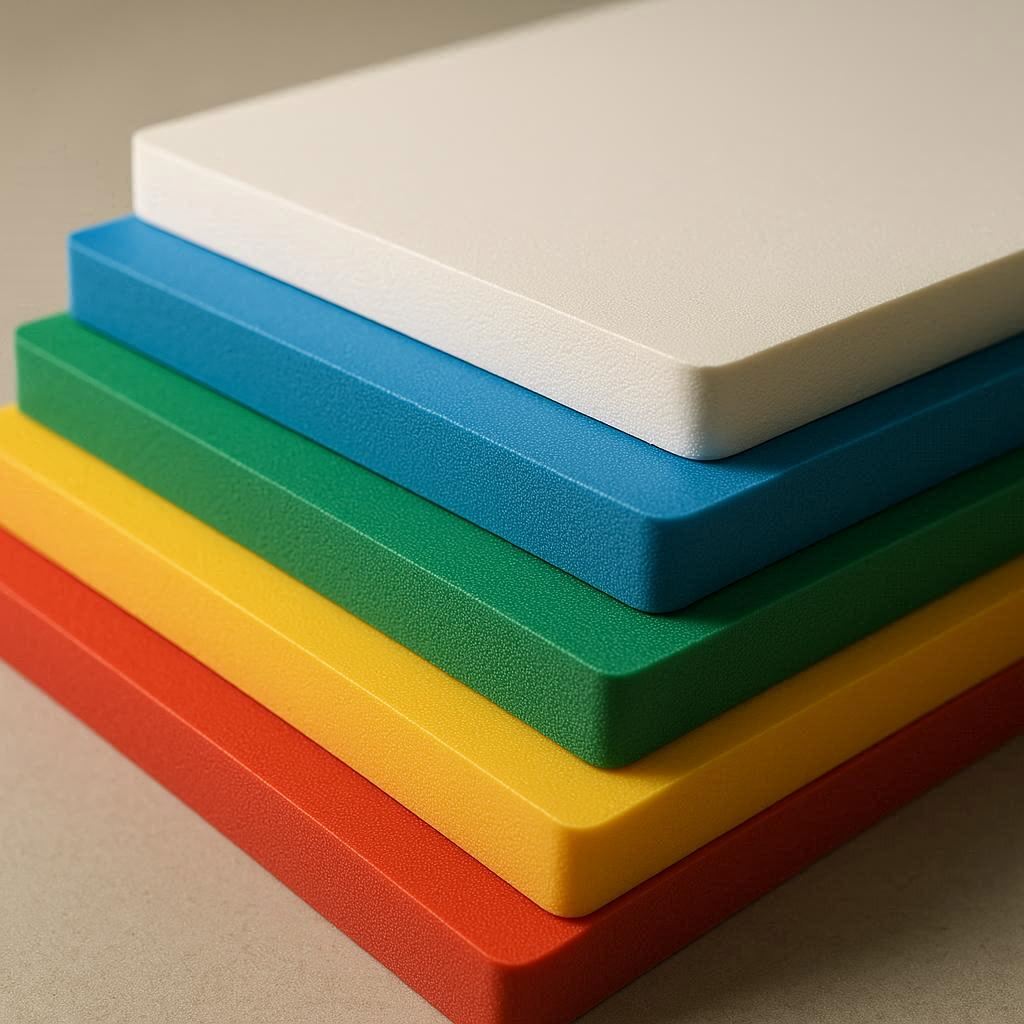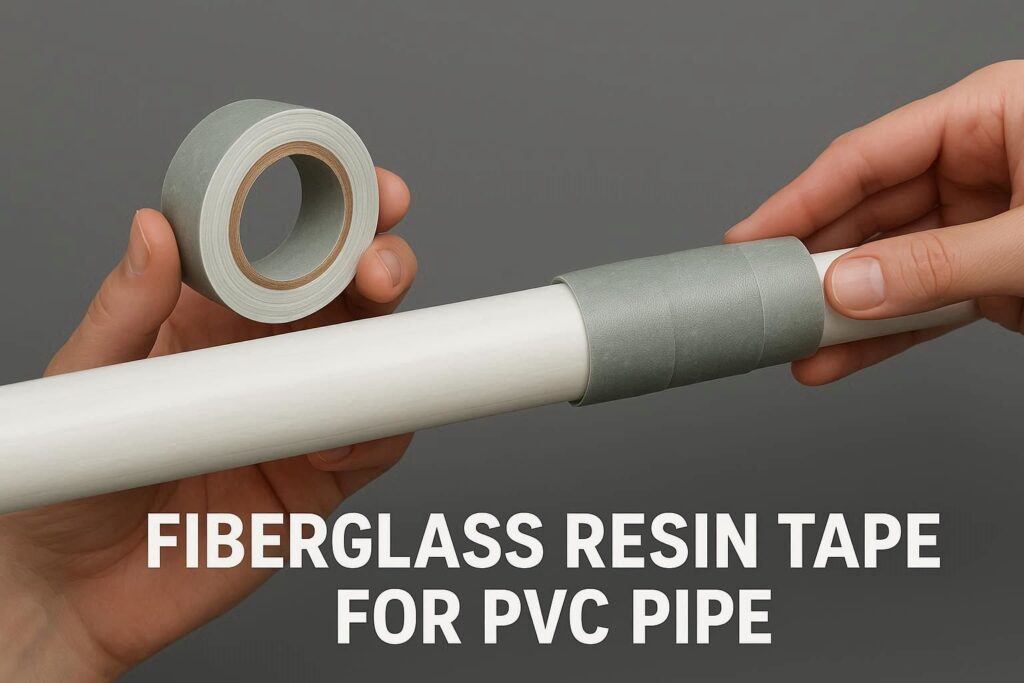In the modern world of manufacturing, which is changing with each passing day, low-density PVC plastic is among the versatile materials that hold high value for a variety of industries. Be it packaging solutions or construction applications, this amazing polymer is still finding newer ways of helping us approach the modern challenges of manufacturing. Understanding the amazing benefits of low-density PVC plastic will help a business make better decisions aimed at increasing efficiency, cutting costs, and improving product performance.
What Makes Low Density PVC Plastic So Special?
Low-density PVC plastic is also known as LDPE and is considered a breakthrough in polymer technology. Apart from high-density, low-density PVC plastic possesses some exclusive properties, making it suitable for applications requiring flexibility, transparency, and chemical resistance. From food packaging to medical devices, this innovative material has changed the face of industries by delivering performance and reliability continuously.
The molecular structure of low density polyvinyl chloride plastic creates a material that couples strength with flexibility, perfect for applications where conventional rigid plastics would fail. The branched polymer chains permit more molecular movement, giving it the characteristic flexibility that has made low-density PVC plastic indispensable in today’s manufacturing.
The 12 Amazing Benefits of Low Density PVC Plastic
1. Exceptional Flexibility and Durability
One of the most remarkable characteristics of low density PVC plastic is its outstanding flexibility without compromising durability. This unique combination allows manufacturers to create products that can withstand repeated bending, stretching, and compression without cracking or breaking. Industries such as packaging, automotive, and consumer goods have embraced low density PVC plastic for applications where traditional rigid materials would prove inadequate.
The flexibility of low density polyvinyl chloride plastic stems from its molecular structure, which allows the polymer chains to move freely while maintaining their integrity. This property makes it ideal for creating flexible packaging films, squeeze bottles, and other products that require both durability and pliability.
2. Superior Chemical Resistance
Low density PVC plastic exhibits remarkable resistance to a wide range of chemicals, including acids, bases, and organic solvents. This property makes it invaluable in industries where exposure to harsh chemicals is common. Chemical processing plants, laboratories, and manufacturing facilities rely on low density PVC plastic for containment systems, piping, and protective equipment.
The chemical resistance of low density polyvinyl chloride plastic ensures long-term performance even in demanding environments, reducing maintenance costs and improving safety standards across various applications.
3. Cost-Effective Manufacturing Solution
From an economic perspective, low density PVC plastic offers significant advantages over alternative materials. Its relatively low production costs, combined with excellent processing characteristics, make it an attractive option for manufacturers seeking to optimize their production budgets. The ability to process low density PVC plastic using standard equipment further reduces capital investment requirements.
Additionally, the lightweight nature of low density polyvinyl chloride plastic reduces transportation costs, making it an economically viable choice for large-volume applications where shipping expenses can significantly impact overall profitability.
4. Outstanding Electrical Insulation Properties
Low density pvc plastic serves as an excellent electrical insulator, making it indispensable in the electronics and electrical industries. Its high dielectric strength and low electrical conductivity ensure safe and reliable performance in applications ranging from cable insulation to electronic component housings.
The electrical insulation properties of low density polyvinyl chloride plastic remain stable across a wide temperature range, providing consistent performance in diverse environmental conditions. This reliability has made it a preferred material for critical electrical applications where safety and performance cannot be compromised.
5. Excellent Moisture Barrier Protection
One of the most valued properties of low density PVC plastic is its ability to provide exceptional moisture barrier protection. This characteristic makes it ideal for packaging applications where protecting contents from humidity and moisture is crucial. Food packaging, pharmaceutical containers, and electronic component protection all benefit from the moisture barrier properties of low density PVC plastic.
The low permeability of low density polyvinyl chloride plastic to water vapor ensures that packaged products maintain their quality and integrity throughout their shelf life, reducing waste and improving customer satisfaction.
6. Versatile Processing Capabilities
Low density pvc plastic can be processed using various manufacturing techniques, including blow molding, injection molding, extrusion, and thermoforming. This versatility allows manufacturers to choose the most appropriate processing method for their specific applications, optimizing both quality and cost-effectiveness.
The processing flexibility of low density polyvinyl chloride plastic enables the creation of complex shapes and designs that would be difficult or impossible to achieve with other materials. This capability opens up new possibilities for product innovation and design optimization.
7. Lightweight Yet Strong Construction
Despite its lightweight nature, low density PVC plastic offers impressive strength-to-weight ratios. This combination is particularly valuable in applications where weight reduction is critical, such as automotive components, aerospace applications, and portable equipment.
The strength characteristics of low density polyvinyl chloride plastic allow manufacturers to reduce material thickness without compromising structural integrity, leading to material savings and improved product performance.
8. Temperature Stability and Performance
Low density PVC plastic maintains its properties across a broad temperature range, making it suitable for applications in various climatic conditions. Whether exposed to freezing temperatures or moderate heat, low density PVC plastic continues to perform reliably without significant degradation.
This temperature stability makes low density polyvinyl chloride plastic ideal for outdoor applications, frozen food packaging, and products that must function in diverse environmental conditions.
9. FDA Approval for Food Contact Applications
Many grades of low density PVC plastic have received FDA approval for direct food contact, making them safe for food packaging and processing applications. This regulatory approval opens up significant market opportunities in the food and beverage industry, where safety and compliance are paramount.
The food-safe properties of low density polyvinyl chloride plastic ensure that packaged foods maintain their quality and safety throughout the supply chain, from production to consumer consumption.
10. Recyclability and Environmental Benefits
Low density PVC plastic can be recycled and reprocessed into new products, contributing to environmental sustainability efforts. The recyclability of low density PVC plastic helps reduce waste and conserve natural resources, aligning with increasingly important environmental regulations and corporate sustainability goals.
Many recycling programs specifically accept low density polyvinyl chloride plastic products, making it easier for consumers and businesses to participate in responsible waste management practices.
11. Transparency and Clarity Options
Depending on formulation and processing conditions, low density PVC plastic can be produced with excellent transparency and clarity. This property is valuable in applications where visual inspection of contents is important, such as food packaging, medical containers, and display applications.
The clarity of low density polyvinyl chloride plastic can be maintained throughout its service life, ensuring that packaged products remain visible and appealing to consumers.
12. Low Maintenance Requirements
Products made from low density PVC plastic typically require minimal maintenance throughout their service life. The material’s resistance to environmental factors, chemicals, and wear reduces the need for frequent repairs or replacements, lowering the total cost of ownership.
This low maintenance characteristic makes low density polyvinyl chloride plastic particularly attractive for applications where access for maintenance is difficult or costly, such as underground installations or remote equipment housings.
Comparative Analysis: Low Density PVC Plastic vs. Alternative Materials
| Property | Low Density PVC Plastic | High Density Polyethylene | Polypropylene | PVC |
|---|---|---|---|---|
| Flexibility | Excellent | Good | Fair | Poor |
| Chemical Resistance | Excellent | Very Good | Good | Excellent |
| Cost Effectiveness | High | High | High | Medium |
| Temperature Range | -40°C to 80°C | -40°C to 120°C | -20°C to 140°C | -10°C to 60°C |
| Electrical Insulation | Excellent | Excellent | Very Good | Good |
| Moisture Barrier | Very Good | Good | Fair | Excellent |
| Transparency | Good | Poor | Good | Excellent |
| Recyclability | Yes | Yes | Yes | Limited |
| FDA Food Contact | Yes | Yes | Yes | Limited |
| Processing Versatility | Excellent | Good | Excellent | Good |
Key Applications Across Industries
Packaging Industry
Low density PVC plastic dominates the flexible packaging sector, with applications including:
- Food packaging films and bags
- Pharmaceutical blister packs
- Protective wrapping materials
- Shrink films and stretch wraps
- Disposable containers and lids
Construction and Building Materials
The construction industry leverages low density PVC plastic for:
- Vapor barriers and moisture protection
- Flexible piping systems
- Insulation materials
- Roofing membranes
- Window and door seals
Automotive and Transportation
Low density pvc plastic finds extensive use in:
- Interior trim components
- Flexible fuel lines
- Protective covers and shields
- Sound dampening materials
- Electrical wire insulation
Medical and Healthcare
Healthcare applications of low density pvc plastic include:
- Disposable medical devices
- Flexible tubing and catheters
- Pharmaceutical packaging
- Laboratory equipment
- Sterile barrier films
Electronics and Electrical
The electronics industry utilizes low density PVC plastic for:
- Cable insulation and jacketing
- Component housing and protection
- Flexible printed circuit substrates
- Connector seals and gaskets
- Electronic equipment enclosures
Environmental Considerations and Sustainability
Low density PVC plastic contributes to environmental sustainability through several mechanisms. Its lightweight nature reduces transportation fuel consumption, while its durability extends product lifecycles, reducing replacement frequency. The recyclability of low density polyvinyl chloride plastic supports circular economy principles, allowing waste materials to be transformed into new products.
Modern production processes for low density PVC plastic have become increasingly efficient, reducing energy consumption and minimizing waste generation. Many manufacturers now incorporate recycled content into new low density polyvinyl chloride plastic products, further enhancing their environmental profile.
Future Innovations and Developments
Research and development in low density PVC plastic technology continues to drive innovation across multiple fronts. Advanced formulations are being developed to enhance specific properties such as UV resistance, antimicrobial properties, and biodegradability. These innovations promise to expand the application range of low density polyvinyl chloride plastic while addressing evolving market demands.
Nanotechnology integration is another promising area, with nanocomposite low density polyvinyl chloride plastic materials offering enhanced barrier properties, improved mechanical strength, and novel functionalities. These advanced materials are expected to open new market opportunities in high-performance applications.
Quality Control and Testing Standards
Ensuring consistent quality in low density PVC plastic products requires comprehensive testing and quality control measures. Standard testing protocols evaluate properties such as tensile strength, elongation at break, tear resistance, and environmental stress crack resistance. These tests ensure that low density polyvinyl chloride plastic products meet specified performance requirements and regulatory standards.
International standards organizations have established specific testing methods for low density polyvinyl chloride plastic, providing manufacturers and users with reliable benchmarks for quality assessment. Compliance with these standards is essential for maintaining product quality and customer confidence.
Cost Analysis and Economic Benefits
The economic advantages of low density polyvinyl chloride plastic extend beyond raw material costs. Processing efficiency, reduced waste generation, and lower energy requirements contribute to overall cost savings. The versatility of low density pvc plastic allows manufacturers to consolidate their material inventory, reducing complexity and storage costs.
Long-term cost benefits include reduced maintenance requirements, extended service life, and recyclability value. These factors combine to create a compelling economic case for low density polyvinyl chloride plastic adoption across diverse applications.
Frequently Asked Questions (FAQ)
Q1: What is the difference between low density and high density PVC plastic?
A: Low density pvc plastic has a branched molecular structure that provides greater flexibility and lower crystallinity compared to high-density variants. This results in better flexibility, clarity, and processability, while high-density versions offer greater strength and chemical resistance. The choice depends on specific application requirements.
Q2: Is low density PVC plastic safe for food packaging?
A: Yes, many grades of low density pvc plastic have received FDA approval for direct food contact applications. These food-grade formulations meet strict safety requirements and are widely used in food packaging, containers, and processing equipment.
Q3: Can low density PVC plastic be recycled?
A: Low density pvc plastic is recyclable and can be reprocessed into new products. It’s typically identified with recycling code #4 and is accepted by many recycling programs. The recycled material can be used to manufacture new products, supporting circular economy principles.
Q4: What temperature range can low density PVC plastic withstand?
A: Low density pvc plastic typically performs well in temperatures ranging from -40°C to 80°C (-40°F to 176°F). However, specific temperature limits may vary depending on the exact formulation and application requirements.
Q5: How does low density PVC plastic compare to other packaging materials?
A: Low density pvc plastic offers excellent flexibility, good moisture barrier properties, and cost-effectiveness compared to alternatives. It provides better clarity than high-density polyethylene and superior flexibility compared to rigid plastics, making it ideal for flexible packaging applications.
Q6: What are the main processing methods for low density PVC plastic?
A: Low density pvc plastic can be processed using blow molding, injection molding, extrusion, thermoforming, and rotational molding. This versatility allows manufacturers to choose the most suitable method for their specific product requirements and production volumes.
Q7: Is low density PVC plastic environmentally friendly?
A: Low density pvc plastic offers several environmental benefits including recyclability, lightweight nature (reducing transportation emissions), and durability (extending product life). Modern production methods have also improved energy efficiency and reduced environmental impact.
Q8: What industries use low density PVC plastic most frequently?
A: The packaging industry is the largest consumer of low density pvc plastic, followed by construction, automotive, medical, and electronics industries. Its versatility makes it suitable for diverse applications across these sectors.
Q9: How does low density PVC plastic perform in outdoor applications?
A: Low density polyvinyl chloride plastic performs well in outdoor applications, maintaining its properties across various weather conditions. UV-stabilized grades are available for applications requiring extended outdoor exposure, providing enhanced resistance to sunlight degradation.
Q10: What quality standards apply to low density PVC plastic products?
A: Low density polyvinyl chloride plastic products must meet various international standards including ASTM, ISO, and FDA regulations depending on the application. These standards specify requirements for mechanical properties, chemical resistance, food safety, and environmental performance.
Low density pvc plastic continues to prove its value across countless applications, offering a unique combination of properties that few materials can match. As technology advances and environmental considerations become increasingly important, low density polyvinyl chloride plastic remains at the forefront of material innovation, providing sustainable solutions for tomorrow’s challenges while meeting today’s demanding requirements.









